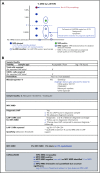Minimal/measurable residual disease in AML: a consensus document from the European LeukemiaNet MRD Working Party
- PMID: 29330221
- PMCID: PMC5865231
- DOI: 10.1182/blood-2017-09-801498
Minimal/measurable residual disease in AML: a consensus document from the European LeukemiaNet MRD Working Party
Abstract
Measurable residual disease (MRD; previously termed minimal residual disease) is an independent, postdiagnosis, prognostic indicator in acute myeloid leukemia (AML) that is important for risk stratification and treatment planning, in conjunction with other well-established clinical, cytogenetic, and molecular data assessed at diagnosis. MRD can be evaluated using a variety of multiparameter flow cytometry and molecular protocols, but, to date, these approaches have not been qualitatively or quantitatively standardized, making their use in clinical practice challenging. The objective of this work was to identify key clinical and scientific issues in the measurement and application of MRD in AML, to achieve consensus on these issues, and to provide guidelines for the current and future use of MRD in clinical practice. The work was accomplished over 2 years, during 4 meetings by a specially designated MRD Working Party of the European LeukemiaNet. The group included 24 faculty with expertise in AML hematopathology, molecular diagnostics, clinical trials, and clinical medicine, from 19 institutions in Europe and the United States.
© 2018 by The American Society of Hematology.
Conflict of interest statement
Conflict-of-interest disclosure: M.-C.B. received research support (Harmonemia project) from Beckman Coulter. J.C. received research funding from Helsinn Healthcare, Janssen Pharmaceuticals, Merus, and Takeda. S.F. received support from National Institute for Health Research, CRUK, and Bloodwise. T.H. and W.K. are both part owners of Munich Leukemie Laboratory. C.S.H. received research funding from Merck and Sellas. G.J.O. provided consultancy services to Janssen and Sunesis; served on the advisory board for Novartis, Pfizer, BMS, Janssen, Sunesis, Celgene, Karyopharm, Amgen, and Seattle Genetics; and received research funding from Novartis, Janssen, Celgene, Immunogen, and Becton Dickinson. G.J.R. provided consultancy services to AbbVie, Amgen, Amphivena Therapeutics, Astex Pharmaceuticals, Array BioPharma Inc., Celgene, Clovis Oncology, CTI BioPharma, Genoptix, Immune Pharmaceuticals, Janssen Pharmaceutica, Jazz Pharmaceuticals, Juno Therapeutics, MedImmune, Novartis, Onconova Therapeutics, Orsenix, Pfizer, Roche/Genentech, and Sunesis Pharmaceuticals and received research support from Cellectis. G.J.S. received research funding from Novartis, Janssen, Immunogen, and Becton Dickinson. C.T. is part Chief Research Officer and Chief Executive Officer and owner of AgenDix GmbH, a company performing molecular diagnostics. The remaining authors declare no competing financial interests.
Figures
Comment in
-
Consensus on MRD in AML?Blood. 2018 Mar 22;131(12):1265-1266. doi: 10.1182/blood-2018-01-828145. Blood. 2018. PMID: 29567752 No abstract available.
References
-
- Döhner H, Weisdorf DJ, Bloomfield CD. Acute myeloid leukemia. N Engl J Med. 2015;373(12):1136-1152. - PubMed
-
- Hourigan CS, Gale RP, Gormley NJ, Ossenkoppele GJ, Walter RB. Measurable residual disease testing in acute myeloid leukaemia. Leukemia. 2017;31:1482-1490. - PubMed
-
- Baer MR, Stewart CC, Dodge RK, et al. . High frequency of immunophenotype changes in acute myeloid leukemia at relapse: implications for residual disease detection (Cancer and Leukemia Group B Study 8361). Blood. 2001;97(11):3574-3580. - PubMed
Publication types
MeSH terms
Grants and funding
LinkOut - more resources
Full Text Sources
Other Literature Sources
Medical


